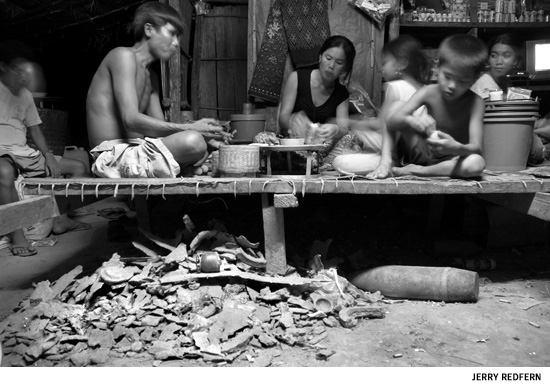
In 2005, Jerry Redfern and Karen Coates were in Laos reporting a story on the Plain of Jars region for Archaeology magazine, and they kept meeting people who had a “bomb problem.” The husband-and-wife team—he’s a photographer, she’s a writer—had lived in Southeast Asia for a number of years, and they were not unfamiliar with the problem of unexploded ordnance leftover from US bombing during the Vietnam War. But until this trip, they hadn’t fully understood, as they put it, “the daily deadliness” of it. They decided it was a story they needed to pursue. Using old US Air Force maps to guide them to areas that were heavily bombed, they spent the next several years talking to the farmers and scrap-metal hunters for whom the risk of death or serious injury is a daily reality. Eternal Harvest, the book that emerged from these conversations, will be published in June.
JR: As long as the stuff stays undisturbed in the ground, it generally isn’t a problem to walk on it. It gets dangerous when you are out with the locals gathering scrap metal, and someone walks up to you with a cluster bomb they found.
The photo above was taken in the village of Etoum, which was so littered with ordnance that when the farmers set their fields on fire to clear them, the land would literally explode.
JR: One day when we were in Etoum, Karen and I were talking and I heard the sound of metal striking metal. I walked around the corner of this hut and there was a guy banging on a bomb detonator with a crowbar, trying to separate the higher-quality metal. It was like something out of a Bugs Bunny cartoon.
What did you do?
JR: I ran. Well, first I took a picture, then I ran.
In many villages, farming and gathering scrap metal form two halves of a seasonal livelihood. When it is too dry to farm, it’s a good time to look for scrap. And during the monsoon season, bombs leach from saturated earth. Middlemen, often from Vietnam, come with trucks to take the villagers into the countryside to hunt for metal, paying them as little as 7 to 10 cents a pound.
KC: We went to a village near the Vietnam border that had been heavily bombed, where everyone had a metal detector because everyone collected scrap. About a year before we got there, a boy had been killed in an explosion. He found what they think was one of these remote-control sensors that the US dropped along the Ho Chi Minh Trail. They would stick in the ground, and detect the movement of trucks and such. And they were often booby-trapped. We spent an entire afternoon and the next morning talking to his parents, visiting his grave, talking to others who had been with the boy when he was killed, including three other villagers who were seriously injured. It took hours to tease out the details of what happened.
Getting around in Laos was difficult, but it also played into Redfern and Coates’s approach to their work, which they describe as “slow journalism.”
KC: One day, we were walking down a dirt road, not sure where it was headed, but something told us to keep going. Eventually we came to this village. It was the hottest part of the day, and most people were not outside, but we asked someone whether they had a bomb problem. Suddenly, people started coming out of the woodwork; it opened up this amazing conversation. It comes down to spending a lot of time talking to people, just letting things unfold.
The Editors are the staffers of the Columbia Journalism Review.
